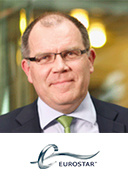INSIGHTS
Eurostar: The Fast Train to Data Center Transformation
At a time when many CIOs struggle to keep the business side satisfied, Eurostar CIO Antoine de Kerviler, boasts that his team no longer has that problem.
“We are completely aligned on the vision, the strategy and the objectives,” he says. “We co-manage roadmaps and budgets. Operating in the cloud has allowed us to be extremely fast and reactive, faster than our business colleagues expected us to be, and to innovate with new services for our customers.”
When we can, we will all be in the cloud. Everything will be in the cloud...We are a train company. Our job is to run and operate trains, it's not to run and operate computers.
The secret to his success may stem from Eurostar’s new approach to managing the flood of data that keeps the trains running on time. Instead of relying only on the company’s three traditional data centers, Eurostar has added cloud services to support its customer-oriented data, including passenger identities, tickets orders, train schedules and much more.
The system includes using Salesforce.com to manage customer relationships and Amazon’s Redshift to store and analyze other data. Eurostar is still using its datacenters to run certain business processes, but things have gone so well that de Kerviler hopes to modernize the entire system.
“When we can, we will all be in the cloud. Everything will be in the cloud,” he says. “We are a train company. Our job is to run and operate trains, it's not to run and operate computers. And there are people out there that are doing it in a much more efficient, greener, faster and more professional way than we can or we'll ever be able to.”
Knowing the Passengers
The rosy future is a contrast with data challenges that are now being resolved. For example, most companies now are collecting more and more information about their customers. But Eurostar sells many tickets through travel agents who don’t like to give out the names or contacts for their clients. Without that information, Eurostar can’t contact the customer to let them know of service delays or other problems.
“There are about 40 percent of our clients for whom we don’t know the name, we don’t know the address, we don’t know the phone number, we don’t know much about them,” says de Kerviler. That can be a problem in a number of ways. For one thing, not knowing who is on the train is a security issue. If there is a wedding party, Eurostar doesn’t even know the name of the bride or groom. In the near future, Eurostar will start requiring passengers to provide a phone number or an email, which will help identify and contact specific passengers, in particular, in case of operational disruption.
“In a way, we’re going to try to behave like an airline and improve the quality of data we have so that we’re in a position to improve the quality of services,” says de Kerviler. As part of that, Eurostar will ask passengers for their preference in communication channels, whether it’s a direct message on Twitter, email, phone, text or another channel.
Cloud Support
“All the customer intelligence is in the process of being transferred into Redshift. It’s all in the cloud,” he says. “And then we’re collecting a lot of data for the customers about travelling – whether your train is late, whether your train is on time, which train, when and so on. We’re cleaning up all that data and putting it in Redshift.”
All this is focused on providing the best possible customer service, he notes. “One of the things we’ve done is to tell people in IS that there’s no such thing as an internal client,” he says. “There’s only one client – the person who sits aboard the train. And we’ve done a number of things to align in this way.”
More Point of Views

Srini Koushik
Chief Technology OfficerMagellan Health
Point of view story
The Traditional Model of IT is Dead - Meet Exponential IT
Zahl Limbuwala
CEO and Co-FounderRomonet



